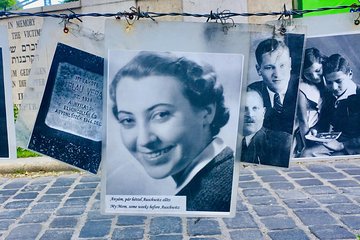Budapest Jewish Heritage: Synagogues, Shoes, Secrets & Flódni
Share this tour

Offered languages
- German
- English
Budapest Jewish Heritage: Synagogues, Shoes, Secrets & Flódni — Private Walking Tour (2.5 hours)
Take a personalized walking tour with a historian guide to uncover Budapest’s rich Jewish heritage. Explore the historic Jewish Quarter and key memorials while tracing the community’s 19th-century integration, the rise of 20th-century antisemitism, and the devastation of the Holocaust. Learn about everyday customs, life in the ghetto after the 1944–45 German occupation, and why many survivors regarded the Red Army’s 1945 arrival as liberation. Along the way, discover landmark synagogues, hidden courtyards and stories behind the “Shoes on the Danube,” and see how Jewish contributions still shape the city’s architecture, culture and food today.
Optional treat: we’ll stop for a flódni tasting (own expense) — flódni is a classic Hungarian-Jewish layered pastry with poppy seed, walnut, apple, and plum jam between thin pastry sheets (contains nuts and gluten).
What's Included
Meeting and pickup
Each time, it's the kind tourist who decides where the most convenient meeting point would be – whether it's a café or their hotel.
Itinerary
-
Fungarian (Pass by)
From Herzl Square and the Great Synagogue we begin the guided walk in the Jewish Quarter, including major landmarks of the city’s World War II ghetto of 1944.
Admission ticket free -
1Great / Central Synagogue (Nagy Zsinagoga)
Stop at the Dohány Street Synagogue, also known as the Great Synagogue is a historical building in Erzsébetváros, the 7th district of Budapest, Hungary. It is the largest synagogue in Europe, seating 3,000 people and is a centre of Neolog Judaism. You will discover not only why this synagogue is unique architecturally, but also find out about the fate of Hungarian Jewry at the time of the Second World War, as well as learning how many internationally famous personages were Hungarian Jews.
20 minutes • Admission ticket not included -
2Rumbach Street Synagogue
Stop at the Moorish Rumbach Sebestyén utca Synagogue was built in 1872 by Austrian Secessionist architect Otto Wagner for the "moderate Conservative" community. The interior decorations shine in their old, graceful light after the long-overdue facelift. Come with us and see this unusual and beautiful synagogue and find out how it differs from the others in the area.
15 minutes • Admission ticket not included -
3Carl Lutz Memorial
During the war, Swiss diplomat Carl Lutz helped save tens of thousands of Jews in Budapest from persecution and deportation. Located in the area of the former Budapest ghetto is a monument dedicated to his memory.
10 minutes • Admission ticket free -
4Kazinczy Street Synagogue
In a small side-street you can find Budapest's Orthodox synagogue. The Orthodox Synagogue was built in 1913 in what was at the time a very modern design. It has late art nouveau touches and is decorated in bright colours throughout. The stained-glass windows in the ceiling were designed by Miksa Róth.
10 minutes • Admission ticket not included -
5Shoes on the Danube Bank
We pay our respects at the Shoes on the Danube Bank memorial, which was unveiled on April 16, 2005, in memory of the Jewish victims who were murdered at this site during World War II. They were forced to remove their shoes before being shot at the riverbank, their bodies carried away by the Danube. The sculpture, depicting the shoes left behind, stands as a poignant symbol of loss and remembrance.
10 minutes • Admission ticket included -
6Budapest's Jewish Quarter
Towards the end of WWII, the Jews of Budapest were herded into a ghetto, and a small section of the ghetto’s wall still stands in the heart of Budapest. Come with us and find out the secrets of the ghetto, the life of its inmates and their eventual fate.
15 minutes • Admission ticket free -
7
End the tour with a bite of history – flódni, a heritage of flavors.
20 minutes • Admission ticket free
Additional info
- Infants and small children can ride in a pram or stroller
- Service animals allowed
- Public transportation options are available nearby
- Suitable for all physical fitness levels
Tags
Cancellation Policy
For a full refund, cancel at least 24 hours before the scheduled departure time.
Show more
Cancellation Policy
- For a full refund, you must cancel at least 24 hours before the experience’s start time.
- If you cancel less than 24 hours before the experience’s start time, the amount you paid will not be refunded.
- Any changes made less than 24 hours before the experience’s start time will not be accepted.
Rating
You can cancel up to 24 hours in advance of the experience for a full refund.
Your guide to the flawless travel experience










